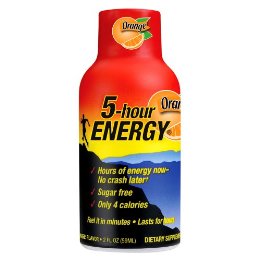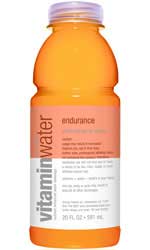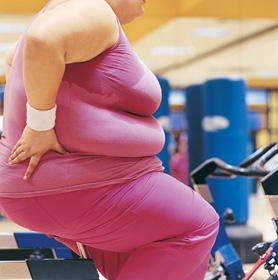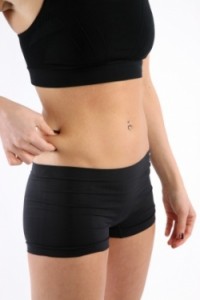
Recent Blog Posts
May 31, 2010
5-Hour Energy?
If you’ve watched cable TV lately, you’ve likely seen the commercials for a product called 5-Hour Energy. The product promises “long-lasting energy without the crash.” It’s an intriguing claim. The question is, does it have any credence?

Like all of these types of products, 5-Hour Energy contains a “proprietary blend” of ingredients. This means the manufacturer doesn’t disclose the exact formula purported to produce results. Fair enough. A look at the ingredient list, however, does shed a good deal of light on the potential efficacy of the supplement.
On the plus side, 5-Hour Energy contains no sugar, supporting the claims that it won’t produce a crash. Consuming high levels of simple sugars causes hyperglycemia, which initiates an insulin spike to remove the excess sugar from circulation. This causes a rebound effect, where a hypoglycemic state is induced, resulting in lethargy. No sugar means no rebound effect and thus no crash. Unfortunately, though, that’s where the good news ends.
A major component of the supplement is a variety of B-vitamins, including vitamin B-3 (niacin), B-6, B-9 (folic acid), and B-12. The B-vitamins have a variety of functions in the body, including acting as co-factors in the production of energy. However, don’t be fooled into thinking that this means increasing B-vitamin consumption will increase energy levels. Provided you consume adequate amounts of B-vitamins (which is relatively easy to do as long as you eat a balanced diet), taking more confers no additional benefits with respect to energy production.
5-Hour Energy also contains an “energy blend” that includes citicoline, tyrosine, phenylalanine, taurine, malic acid, and glucuronolactone. While all of these ingredients have putative functions in supporting cognition, memory, mood, and other markers of mental well-being, they are obtained either through your diet or through normal bodily processes. Research into the advantages of supplementation have failed to show any clear benefits.
The primary component in 5-Hour Energy likely to give an energy boost is good old caffeine. According to the manufacturer, 5-Hour Energy contains as much caffeine as a cup of the leading premium coffee. And this is the rub: You can brew a cup of java for a fraction of the cost of the product and get essentially the same benefits. With this in mind, the decision becomes a no-brainer: don’t waste your money.
Stay Fit!
Brad
May 26, 2010
Post-Workout Nutrition
Make no mistake, what you eat following exercise can have a major impact on your results. After an intense workout, your body is in a catabolic state. It has spent a good deal of its stored fuels (including glycogen and amino acids) and in most cases sustained damage to its muscle fibers. The good news is that this presents a window of opportunity for anabolism. By consuming the proper ratio of nutrients during this time, not only do you initiate the rebuilding of damaged tissue and energy reserves, but you do so in a supercompensated fashion that fosters improvements in both body composition and exercise performance.
One of the primary goals post-exercise is to replenish glycogen (stored carbohydrate). Because glucose is depleted during training, your muscles and liver are literally starved for carbohydrate. In response, several adaptations take place. For one, the transporters responsible for bringing glucose into muscle cells (called GLUT4) become much more active. For another, your body stimulates the activity of glycogen synthase—the principle enzyme involved in promoting glycogen storage. The combination of these factors facilitates the rapid uptake of glucose into muscles, allowing glycogen to be replenished at an accelerated rate.

Carbohydrates are best taken in liquid form and should come from simple, high-glycemic sources. This is one instance where it is beneficial to spike insulin levels. You see, insulin has both anabolic and anti-catabolic functions, helping to increase protein synthesis, decrease protein breakdown, and shuttle glycogen into cells. And this is one instance where elevated insulin won’t promote increases in body fat. Because your muscles are in a depleted state, nutrients will tend to be used for lean tissue purposes rather than fat storage.
A combination of glucose and fructose is ideal, here. In addition to eliciting an insulin response, glucose is the primary source of muscle glycogen. Fructose, on the other hand, preferentially replenishes liver glycogen (glucose is of limited utility to the liver, a phenomenon called the “glucose paradox”). Thus, the two types of sugar work synergistically to restock the body’s glycogen stores.
Grape, apple, and cranberry juices are generally good choices since they have a high ratio of glucose to fructose. A good starting point is to consume ½ gram of carbs per pound of “ideal” bodyweight. Thus, if your goal weight is 120 pounds, then you’d consume 60 grams of carbs. For those who are “carb sensitive,” cut this amount back to ¼ gram of carbs per pound of body weight. Over time, assess how your body responds and modify the amount based on individual response.
The other main nutritional objective post-workout is to supply sufficient protein for tissue repair. If protein intake is inadequate following training, recuperation is shortchanged and results are comprised.
Protein should preferably be in the form of a high-quality protein powder. The idea is to saturate your muscles in amino acids, providing them with the raw materials to facilitate recovery. When amino acids are consumed following training, protein synthesis is increased more than threefold over fasting conditions, optimizing the development of lean muscle tissue.
A fast-acting protein such as whey works best. Because it is rapidly assimilated, whey reaches your muscles quickly, thereby expediting repair. And since your muscles are primed for anabolism, virtually all of the protein will be utilized for rebuilding with little wastage. Recent evidence suggests that combining whey with some casein can have even greater effects on protein synthesis, but this needs further study. Aim for ¼ gram of protein per pound of body weight, mixing the powder directly into your post-workout drink.
Refrain from consuming fats following your workout. Dietary fat slows gastric emptying, delaying the time that glucose and amino acids can enter the bloodstream and be used by the body. And if nutrients don’t reach your muscles in a timely fashion, results will suffer.
Caffeinated beverages should also be avoided during the post-workout period. Caffeine interferes with post-exercise insulin action, thereby impairing your body’s ability to replenish glycogen stores and utilize protein for muscular repair. Hence, wait at least a couple of hours after your workout before indulging in that cup of coffee or tea.
Ideally, you should consume your post-workout meal as soon as possible after training. The quicker you feed your body, the more it sops up nutrients and utilizes them for repair. Since blood flow is increased from the exercise bout, the delivery of protein and carbs is enhanced, resulting in greater muscle protein synthesis. But even if you are unable to consume your post-workout meal immediately upon cessation of training, all is not lost. The window of opportunity lasts for at least a couple of hours following exercise so just make sure you take in the specified nutrients as soon as you can.
Stay Fit!
Brad
May 17, 2010
Appearance on Weekend Today in NY
In case you missed, here is a link to my appearance on Weekend Today in NY. The topic was how to get your abs into swimsuit shape. Enjoy!
Get Into Swimsuit Shape for Summer!
Stay Fit!
Brad
May 14, 2010
The Skinny on Vitamin Water
You may have seen commercials for a product called Vitamin Water. Vitamin Water is marketed as a “great-tasting, healthy enhanced water that is packed with nutrients” as well as “…providing a perfect complement to everyone’s less-than-perfect diet…” However, a look at the ingredients reveals otherwise…

Vitamin Water is not simply water with added vitamins. It contains 50 calories of sugar, which come in the form of crystalline fructose. Now 50 calories of sugar by itself is generally no big deal, but the calories definitely add up if you consume multiple bottles of the product–which apparently many people do. Moreover, fructose has been shown to be lipogenic, meaning it preferentially promotes fat storage. Given that the body has limited ability to store fructose as glycogen (only the liver can store fructose–muscles lack an enzyme critical for storage), gulping down several drinks could easily result in an increase in body fat.
More to the point, you would be much better served by taking a multi-vitamin/mineral complex to satisfy any additional micronutrient needs not met by the foods in your diet. You can get a month’s worth of vitmains and minerals from a one-a-day supplement for what you would pay for a single bottle of Vitamin Water!
Bottom line: Save your money on Vitamin Water–the costs outweigh the benefits. If you want to add taste to your water, squeeze in some lemon or lime. It’ll be better for your waist line and your wallet.
Stay Fit!
Brad
May 12, 2010
NSCA Webinar
I will be giving a webinar on the “Facts and Fallacies of Fitness” on Wednesday, June 16 at 2 pm, EST. The webinar is being hosted by the NSCA and will debunk some of the common myths associated with exercise and nutrition in an evidence-based fashion. The webinar is open to the general public and will involve a question/answer session following the presentation. I guarantee it will be informative for all attending. You can register for the webinar at the link below:
Brad Schoenfeld Webinar: “Facts and Fallacies of Fitness”
Stay Fit!
Brad
May 10, 2010
Can You Be Fit and Fat?
Is it possible to be fit if you’re fat? A study by Weinstein et al. (2008) sheds some light on the issue. The study investigated the relationship between being overweight/obese (as measured by BMI) and indices of cardiovascular health in over 38,000 middle-aged and older women. Results showed that the overweight/obese subjects who were physically active significantly reduced their risk of coronary heart disease, with greater levels of physical activity associated with an greater reduction in risk. Sounds good, right? Not so fast…

Unfortunately, women who were overweight/obese showed an increase risk for coronary heart disease regardless of physical activity compared to lean women. These results held true even in those who engaged in high levels of exercise. What’s more, the study didn’t consider other health issues associated with obesity, such as cancer, metabolic disorders, and joint disease.
The bottom line is that just because you exercise doesn’t give you Carte Blanche to eat whatever you want. Exercise certainly will make you “fitter” if you’re fat, but the excess weight poses a health risk no matter how active you are. Regardless of activity levels, you still need to watch your waistline!
Stay Fit!
Brad
Weinstein AR, Sesso HD, Lee IM, Rexrode KM, Cook NR, Manson JE, Buring JE, Gaziano JM. The joint effects of physical activity and body mass index on coronary heart disease risk in women. Arch Intern Med. 2008 Apr 28;168(8):884-90
May 4, 2010
The Spot Reduction Myth
Of all the emails I receive, the most common question asked is, “How can I reduce my (fill in the blank with a given body part).” Whether it’s the belly, thighs, butt or any other problem area, my answer is always the same: Sorry, but you can’t spot reduce!

Simply stated, there is no way to dictate what area of your body you lose fat from. It’s a physiologic impossibility. All the sit-ups in the world won’t give you a flat stomach; no amount of lower body exercises will directly diminish the size of your thighs. In reality, trying to eradicate your problem areas with targeted movements is literally an exercise in futility.
A recent study conducted by Redman et al. (2007) demonstrated the senselessness of trying to spot reduce. Thirty-five overweight subjects were placed into one of three random groups: a control group who ate their normal diet; an energy restricted group who reduced calories by 25%; or an energy restriction plus exercise group who reduced calories by 12.5% and increased energy expenditure through exercise by 12.5%. After six months, results showed that although fat depots were reduced by approximately 30% in men and 25% in women in both the calorie restricted and the calorie restricted plus exercise groups, the distribution of the fat depots were reduced equally throughout the whole body. This study used both dual energy X-ray absorptiometry (DEXA) and multi-slice computed tomograpy (CT) to evaluate fat mass, adding to the validity of results.
In order to appreciate why spot reduction doesn’t work, it is necessary to understand how fat is synthesized. When calories are consumed in abundance, your body converts the excess nutrients into fat-based compounds called triglycerides, which are then stored in cells called adipocytes. Adipocytes are pliable storehouses that either shrink or expand to accommodate fatty deposits. They are present in virtually every part of the body. There is a direct correlation between the size of adipocytes and obesity: the larger your adipocytes, the fatter you appear.
When you exercise, triglycerides are broken back down into fatty acids, which are then transported via the blood to be used in target tissues for energy. Because fatty acids must travel through the circulatory system—a time-consuming event—it is just as efficient for your body to utilize fat from one area as it is another. In other words, the proximity of fat cells to the working muscles is completely irrelevant from an energy standpoint. Since the body can’t preferentially use fat from a particular area, it simply draws from adipocytes in all regions of the body including the face, trunk and extremities.
Bottom line: When you exercise, fat will be burned globally throughout your body. Some areas will be more sensitive to fat loss than others, but over time you will lean out even the most stubborn problem areas provided you stay regimented with your exercise routine and maintain a caloric deficit.
Stay Fit!
Brad
Redman LM, Heilbronn LK, Martin CK, Alfonso A, Smith SR, Ravussin E; Pennington CALERIE Team. Effect of calorie restriction with or without exercise on body composition and fat distribution. J Clin Endocrinol Metab. 2007 Mar;92(3):865-72





 Entries (RSS)
Entries (RSS)



